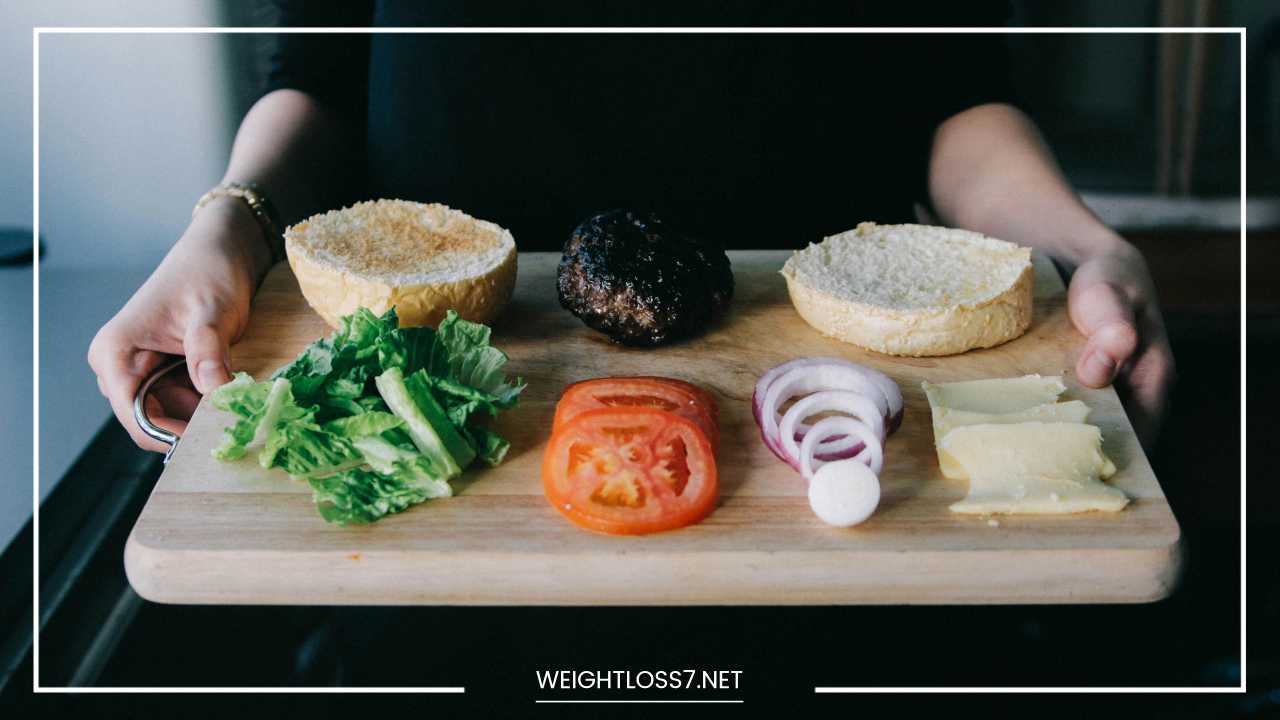Eat to Lose Weight: Keeping Metabolism High

Healthy Eating
Eat to Lose Weight: Keeping Your Metabolism Revved Up
For many, the words “weight loss” conjure up images of bland salads, tasteless meals, and relentless calorie counting.
But what if you could shed pounds while still enjoying delicious and satisfying food? Here’s the key: focusing on optimizing your metabolism.
Your metabolism is the complex process your body uses to convert food into energy. It’s responsible for everything from powering your workouts to keeping your organs functioning smoothly.
A higher metabolic rate means your body burns more calories throughout the day, even at rest. This creates a calorie deficit, essential for shedding unwanted weight and achieving a healthy body composition.
Debunking the Metabolism Myths
One common misconception is that metabolism slows down dramatically with age or during weight loss. While there is a slight natural decline as we get older, it’s often minimal.
The bigger concern is muscle loss, which can contribute to a slight decrease in metabolic rate. Muscle burns more calories than fat at rest, so preserving muscle mass is key.
Additionally, the idea that “starving yourself” speeds up metabolism is not only untrue but also counterproductive. Restrictive diets can actually lead to a decrease in metabolism as your body goes into “conservation mode” to hold onto energy.
Food as Fuel: Strategies for a High-Metabolism Lifestyle
The good news is, you have significant control over your metabolic rate through your diet. Here’s a deeper dive into the specific strategies you can use to keep your body’s internal furnace burning brightly:
1. Protein Powerhouse: Embrace the Thermogenic Effect
Protein reigns supreme when it comes to boosting metabolism. The body burns more calories digesting and processing protein compared to carbs or fat, thanks to the thermic effect of food (TEF). Aim for protein sources like lean meats, poultry, fish, eggs, legumes, and tofu in every meal. Here’s the breakdown:
- Lean meats: Chicken breast, turkey breast, lean ground beef (90% lean or higher), bison
- Poultry: Chicken thighs, drumsticks (skin removed), duck breast
- Fish: Salmon, tuna, cod, sardines, mackerel
- Eggs: Whole eggs or egg whites provide complete protein and essential nutrients.
- Legumes: Black beans, lentils, kidney beans, chickpeas (great option for vegetarians and vegans)
- Tofu: A versatile source of plant-based protein, perfect for stir-fries, scrambles, or marinades.
Pro Tip: Experiment with different protein sources throughout the week to keep your meals exciting and ensure you’re getting a variety of nutrients.
2. Fiber Friend: Digestion Dynamo
Fiber keeps you feeling fuller for longer, preventing overeating and unwanted snacking. But it also plays a crucial role in metabolism.
High-fiber foods like fruits, vegetables, whole grains, and legumes take longer to digest, requiring your body to expend more energy during the process.
Here are some excellent high-fiber choices to incorporate into your daily meals:
- Fruits: Berries, apples, pears, kiwifruit, oranges, grapefruit
- Vegetables: Leafy greens (spinach, kale), broccoli, cauliflower, asparagus, Brussels sprouts
- Whole grains: Brown rice, quinoa, oats, whole-wheat bread, whole-wheat pasta
- Legumes: As mentioned above, these are a double win for protein and fiber.
Pro Tip: Aim for a variety of colors on your plate. Different colored fruits and vegetables provide a wider range of vitamins, minerals, and antioxidants.
3. Don’t Fear Healthy Fats: Friends, Not Foes
Healthy fats, like those found in avocados, nuts, seeds, and olive oil, have gotten a bad rap over the years. However, they are essential for hormone regulation, satiety, and nutrient absorption. Including healthy fats in your diet can help regulate your appetite and prevent blood sugar spikes that can lead to cravings.
Here are some excellent sources of healthy fats to include in your meals:
- Avocados: Rich in healthy monounsaturated fats and fiber. Perfect for toast, salads, or guacamole.
- Nuts: Almonds, walnuts, cashews, pistachios (portion control is key as they are calorie-dense).
- Seeds: Chia seeds, flaxseeds, hemp seeds – sprinkle them on salads, yogurt, or oatmeal.
- Olive oil: Use extra virgin olive oil for drizzling, dressings, or light sauteing.
Pro Tip: Choose raw or dry-roasted nuts and seeds to avoid added sugars and unhealthy fats.
4. Spice Up Your Life: The Chili Pepper Advantage
Capsaicin, the compound that gives chili peppers their heat, can give your metabolism a temporary boost. Studies suggest capsaicin may increase calorie burning and fat oxidation.
While spicy food isn’t a magic bullet, incorporating chili peppers like jalapenos, habaneros, or cayenne pepper into your meals can contribute to a thermogenic effect.
Pro Tip: If you’re new to spicy food, start slowly and gradually increase the amount you consume as your tolerance builds.
5. Stay Hydrated: Water’s Metabolic Marvel
Water is crucial for every bodily function, including metabolism. Even mild dehydration can slow down your metabolic rate. Here’s why:
- Digestive Aid: Water helps break down food and facilitates the absorption of nutrients.
- Nutrient Transport: Water transports essential nutrients throughout the body, ensuring optimal cellular function.
- Temperature Regulation: Water plays a role in regulating body temperature, which impacts metabolic processes.
Aim to drink plenty of water throughout the day. A good rule of thumb is to consume half your body weight in ounces of water daily.
Consider incorporating fruits and vegetables with high water content like watermelon, cucumber, and celery to further boost your hydration.
Pro Tip: Invest in a reusable water bottle and keep it with you throughout the day to ensure you’re sipping regularly.
Beyond Food: Optimizing Your Metabolism for Long-Term Success
While diet plays a major role in keeping your metabolism high, there are other lifestyle habits to consider for a holistic approach:
1. Strength Training: Building a Muscle Machine
Strength training is a fantastic way to build and maintain muscle mass. Muscle tissue burns more calories at rest than fat, so the more muscle you have, the higher your metabolism will be.
Aim for strength training sessions at least 2-3 times a week, focusing on compound exercises that work multiple muscle groups simultaneously. Here are some examples:
- Squats
- Lunges
- Deadlifts
- Push-ups
- Pull-ups
- Rows
- Overhead press
Pro Tip: If you’re new to strength training, consult with a certified personal trainer to learn proper form and technique to avoid injury.
2. Quality Sleep: The Recharge Reset
When you’re sleep-deprived, your body produces more ghrelin, the hunger hormone, and less leptin, the satiety hormone.
This can lead to increased cravings and overeating. Additionally, sleep deprivation can disrupt hormones that regulate metabolism, leading to decreased calorie burning. Aim for 7-8 hours of quality sleep each night to regulate your hormones and metabolism.
Here are some tips to improve your sleep hygiene:
- Establish a regular sleep schedule and stick to it as much as possible, even on weekends.
- Create a relaxing bedtime routine that helps you wind down before sleep.
- Make sure your bedroom is dark, quiet, and cool.
- Avoid screens (phones, laptops, TVs) for at least an hour before bed.
- Limit caffeine and alcohol intake, especially in the evening.
3. Manage Stress: Keeping Cortisol in Check
Chronic stress can wreak havoc on your hormones, including cortisol. Cortisol can lead to increased belly fat storage and hinder weight loss efforts. Here are some effective stress-management techniques:
- Yoga: Combines physical postures, breathing exercises, and meditation for a holistic approach to stress reduction.
- Meditation: Mindfulness meditation helps train your mind to focus on the present moment, reducing anxiety and promoting relaxation.
- Deep Breathing: Deep, slow breaths activate the parasympathetic nervous system, promoting a sense of calm.
- Spending Time in Nature: Immersing yourself in nature has been shown to reduce stress levels and improve mood.
Sample Meal Plan for a Metabolism Boost
Breakfast (High Protein, Fiber):
- Greek yogurt with berries, sliced almonds, and a sprinkle of chia seeds
- Scrambled eggs with spinach and whole-wheat toast
Lunch (Balanced Macronutrients):
- Grilled chicken breast on a bed of mixed greens with quinoa, avocado, and a vinaigrette dressing
- Salmon salad with whole-wheat pita bread and a side of roasted vegetables
Snack (Healthy Fats, Fiber):
- Apple slices with almond butter
- Handful of mixed nuts and dried cranberries
Dinner (Lean Protein, Complex Carbs):
- Baked salmon with roasted sweet potato and steamed broccoli
- Turkey chili with a side of brown rice
Remember: This is just a sample plan, and it’s important to personalize it based on your individual needs and preferences. Be sure to consult a registered dietitian or nutritionist for guidance on creating a sustainable and healthy meal plan for your weight loss goals.
Beyond the Basics: Advanced Strategies for Metabolic Optimization
While the core principles discussed above are fundamental for a healthy metabolism, there are additional strategies you can explore for further optimization.
However, it’s important to note that these strategies may not be suitable for everyone, and consulting with a healthcare professional before implementing them is crucial.
1. Intermittent Fasting (IF): A Time-Restricted Approach
Intermittent fasting (IF) involves cycling between periods of eating and fasting. Studies suggest that IF may offer benefits for metabolic health, including improved insulin sensitivity and increased fat burning.
There are various IF protocols, with the most popular being the 16/8 method (fasting for 16 hours and eating within an 8-hour window).
Important Considerations for IF:
- IF is not recommended for pregnant or breastfeeding women, individuals with certain medical conditions, or those with a history of eating disorders.
- Gradually ease into IF to avoid potential side effects like headaches or fatigue.
- Ensure you’re consuming enough essential nutrients during your eating window.
- Stay hydrated throughout your fasting period.
2. High-Intensity Interval Training (HIIT): The Afterburn Effect
High-intensity interval training (HIIT) involves alternating between short bursts of intense exercise and periods of rest or recovery.
HIIT has been shown to boost metabolism and increase calorie burning even after your workout is complete, thanks to the “afterburn effect.” This phenomenon occurs as your body works to restore itself to a pre-exercise state, burning additional calories in the process.
Benefits of HIIT:
- Time-efficient: HIIT workouts can be completed in a shorter amount of time compared to traditional cardio.
- Improves cardiovascular health and fitness.
- Can be adapted to various fitness levels.
Important Considerations for HIIT:
- HIIT is a demanding form of exercise, so it’s not suitable for everyone. Consult with your doctor before starting HIIT, especially if you have any pre-existing health conditions.
- Proper form is crucial to prevent injury. Consider working with a certified trainer to learn proper HIIT techniques.
- Ensure adequate rest and recovery between HIIT sessions.
3. Mindful Eating: The Power of Awareness
Mindful eating involves paying attention to the physical and emotional cues of hunger and fullness. It encourages slowing down during meals, savoring flavors, and appreciating the act of nourishing your body.
Mindful eating can help you avoid overeating and make more conscious food choices, which can positively impact your metabolism.
Tips for Mindful Eating:
- Eat in a distraction-free environment, away from screens or devices.
- Focus on the sensory experience of your food – the aroma, texture, and taste.
- Chew your food thoroughly and savor each bite.
- Stop eating when you feel comfortably full, not stuffed.
4. Probiotics: Gut Health and Metabolism Connection
The gut microbiome, the community of bacteria in your gut, plays a significant role in overall health, including metabolism.
Studies suggest that a balanced gut microbiome may be associated with a healthy weight and efficient metabolism. Probiotics are live bacteria found in fermented foods like yogurt, kimchi, and kombucha.
While research is ongoing, some studies suggest that probiotics may promote gut health and potentially influence metabolism.
Important Considerations for Probiotics:
- More research is needed to fully understand the link between probiotics, gut health, and metabolism.
- Choose high-quality probiotic supplements with verified strains and colony-forming units (CFUs).
- Consult with your doctor before starting any new supplements, including probiotics.
Remember: Consistency is Key
Optimizing your metabolism is a journey, not a destination. By incorporating the strategies outlined above and creating a sustainable lifestyle, you can keep your body’s internal furnace burning bright and support your weight loss goals.
Remember, the most effective approach is to find a balance that works for you in the long term. Don’t hesitate to consult with a registered dietitian, nutritionist, or healthcare professional for personalized guidance on your weight loss journey.

















